
Endgame Explorations 6: Underpromotion (Part 1)
Noam Elkies
As promised in the previous installment, we turn now to the theme of underpromotion: upon reaching the far rank a pawn may become a knight, rook or bishop instead of the ordinary queen. Now a knight promotion, while unusual, occurs occasionally in practical play, where it affects the outcome of some basic endgames (such as White Kc7, b6, Black Kc5, Rh6: White draws only by 1 b7 Rh7 2 Kc8 Kc6! 3 b8/N+!), provides a crucial middlegame check (usually involving a mating attack or a royal fork-- for a recent example of the latter see No. II of "What's the Best Move?" on page 52 of the 10/89 Chess Life), and concludes the Lasker Trap in the Albin Counter-Gambit, wherein Black wins only by making a third knight on his seventh turn (1 d4 d5 2 c4 e5 3 dxe5 d4 4 e3? Bb4+ 5 Bd2 dxe3! 6 Bxb4 exf2+ 7 Ke2 fxg1/N+!). Last year I had the rare opportunity to promote to a knight without check in the middlegame:
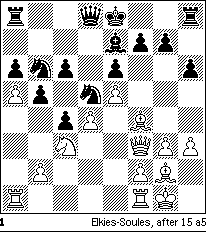
This occurred in a casual speed game; so far we had played normally if not accurately, but now Black begins to "complicate":
15 ... Nxc3?! 16 Qxc6+ Qd7?
Here I could win a piece with 17 bxc3, so 16 ... Kf8 was indicated. But I was
distracted by visions of queening.
17 axb6? Ne2+ 18 Kh1 Rd8 19 b7 0-0
And here 20 b8/Q Qxc6 21 Qxd8 Qxg2 etc. would win the exchange, but then I saw
20 b8/N!!?
When the laughter subsided, play continued 20 ... Qxd4 21 Nxa6 Nxf4 22 gxf4 Qxf4 23 Qxb5 Rd2 24 Ra4 and White eventually repulsed Black's counterplay and cashed in on the extra piece. I later found the alternative 20 Be3 Nxd4 (else the knight gets trapped) and now 21 b8/N!! is the only move and leaves White a piece up without compensation after 21 ... Nxc6 22 Nxd7, 21 ... Qxc6 22 Nxc6, or Qa7 22 Qe4 (of course not 21 ... Rxb8?? 22 Qxd7).
While this setup for a knight promotion would be as atypical in an endgame study (because of all the heavy artillery required) as it is in practical play, endgame composers have created literally hundreds of different contexts for obligatory knightings. Witness the following specimen from the beginning of our century, wherein V. Bron combines underpromotion with the themes of stalemate, domination and zugzwang we've explored in earlier columns:
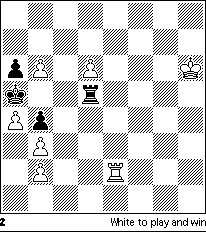
1 Re5!
Diverting the Rd5 from the d-file, else Black draws by snaring both of White's advanced pawns.
1 ... Rxe5 2 d7 Re6+
One of the pawns will queen now, so Black organizes a stalemate defense. The alternative 2 ... Rd5 3 b7 Rxd7 4 b8/Q Rd6(h7)+ etc. (remember the first Endgame Explorations column?) fails because White can contrive to either capture the rook with his queen, breaking the stalemate, or sacrifice queen for rook and win the pawn endgame, e.g.: 4 ... Rd6+ 5 Kg5 Rg6+ 6 Kf5 Rf6+ 7 Ke4 Rf4+ 8 Qxf4 or 7 ... Re6 8 Qe5+!
3 Kg5! Rb6
Hoping for 4 d8/Q stalemate. If 3 ... Rd6 4 b7 Rxd7 5 b8/Q and wins as above.
4 d8/N!!
Mutual zugzwang! Thanks to White's third move, the rook has no safe
square: 4 ... Rxb7 5 Nxb7+ or 4 ... Rd6 5 Nc6+ and White wins.
All these knight promotions are, at least in part, "positive", in that the promoter takes advantage of powers of the knight not shared by the queen; thus, as Tim Krabbe observes in Chess Curiosities, knighting hardly counts as a true "underpromotion". In contrast, a rook or bishop promotion must be purely "negative": since a queen can make any move that a rook or bishop can, such a promotion can only serve to avoid the queen's extra powers. Thus stalemate must be involved, restricting the relevance of these underpromotions in actual play to the endgame, and even there they are very rare. Still, even the most stubbornly result-oriented chessplayer must have seen and enjoyed the rook promotion concluding Saavedra's immortal study:
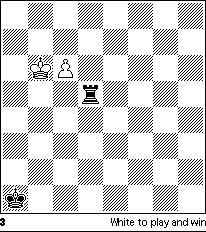
1 c7 Rd6+ 2 Kb5!
The only move to win: if 2 Kb7? Rd7 or 2 Kc5 Rd1 draws.
2 ... Rd5+ 3 Kb4 Rd4+ 4 Kb3(c3) Rd3+(d1) 5 Kc2 Rd4! 6 c8/R!!
Not 6 c8/Q? Rc4+! 7 Qxc4 stalemate.
6 ... Ra4 7 Kb3
And White wins, as Black can prevent the immediate mate only by losing his rook.
This natural-looking position has probably never appeared over the board, but another setup for a rook promotion does occur in practice
from time to time (see for instance page 40 of the October 1988 Chess Life) in endgames such as the following:
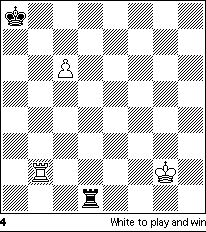
White begins by 1 c7 Rc1 2 Rb8+ Ka7 and now not 3 c8/Q? Rg1+! drawing by stalemate or perpetual check, but 3 c8/R! winning. (But more frequently both players overlook the stalemate resource and Black resigns after 2 Rb8 or even after 3 c8/Q?.) In 1928 Kubbel nicely combined this idea with a knight promotion in the following miniature:
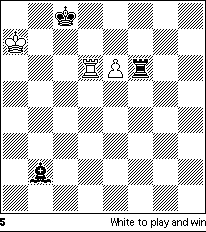
1 e7
Now if 1 ... Rxd6 2 e8/Q+ Kc7 3 Qb8+ and 4 Qxb2, or 2 ... Rd8 3 Qc6#. Black has two similar stalemate defenses which White refutes with different underpromotions:
(A) 1 ... Bd4+! 2 Rxd4
2 Ka8? Rxd6 3 c8/Q+ Kc7 drawing.
2 ... Re6 3 Rd8+ Kc7 4 e8/R! +-
Not 4 e8/Q? Ra6+! =.
(B) 1 ... Kc7
Hoping for 2 e8/Q Bd4+! 3 Rxd4 Ra6+! drawing.
2 e8/N+!
And White wins.
Just as one may underpromote offensively to avoid stalemate, one may underpromote defensively to create stalemate. This effect is hardest to achieve with a rook promotion: while a bishop or knight may be either pinned or immobilized immediately upon promotion, a rook must either move to be pinned or be immobilized later. The pin-stalemate is beautifully demonstrated in this study by the Czech composer Matous:
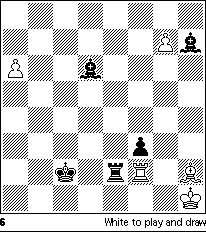
1 a7!
Hopeless are: 1 Bxd6? Rxf2 2 a7 Rf1+ 3 Kh2 Ra1; and 1 Bg1 Bc5 2 Rf1 f2 3 Bh2?
Be4#; and 1 Rxf3? Be4.
1 ... Rxf2 2 Bg1
2 a8/Q? Rxh2+ mates in two. Now 2 ... Be4? 3 Bxf2 and White even wins, so Black sets up a new mating net.
2 ... Rh2+! 3 Bxh2 Be4!
With the point 4 g8/Q f2+ 5 Qg2 Kd1! and now 6 Qxe4 f1/Q+ 7 Bg1 (equivalent to 6 Bg1 f1/Q 7 Qxe4) 7 ... Qh3+ and mate next. Also, if 4 Kg1? Bc5+ 5 Kf1 Bd3+ 6 Ke1 f2#.
4 a8/Q! Bxa8 5 g8/R!! f2+
Black must follow through; 5 ... Bb7 6 Bg1 f2+ 7 Rg2 or 5 ... Bd5 6 Rc8+ and 7 Kg1 is an easy draw.
6 Rg2! Kd1!
To unpin the pawn, else 7 Bg3(g1) draws instantly.
7 Bg1!
And White is stalemated after 7 ... f1/Q (a counter-underpromotion doesn't help Black here: 7 ... f1/R is still stalemate, and the fanciful 7 ... f1/B only draws since a bishop trade will leave Black with insufficient mating material) or after 7 ... Ke1!? 8 Bxf2+ Kf1 9 Bg3! Bxg3.
I leave bishop promotions and various multiple underpromotions for my next column.
Noam Elkies is now Professor of Mathematics at Harvard University and is the author of "Chess Art in the Computer Age," published in ACJ 2 (1993). This article originally appeared in Chess Horizons.Next column: Underpromotion (Part 2).
This page last modified on
28 April 2018.
Copyright (c) 1995-2018 Christopher F. Chabris. All rights
reserved.






